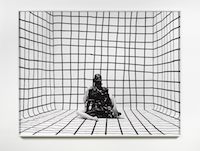Where humans are portrayed in detail—photographically or otherwise—viewers will seek to identify commonalities and differences between themselves and the people represented. This visual process may involve reading psychological states or deciphering clues regarding racial, ethnic, and socioeconomic backgrounds. While the urge to interpret information relayed by other’s bodies may seem natural and innocuous, observers often operate under false assumptions: first, that we are equipped to make categorical determinations, and second, that our conclusions are complete and truthful.
On display at Higher Pictures Generation are eight new works by Gina Osterloh that challenge viewers’ urges and assumptions through eerie, empowering instances of visual blocking. By obscuring, reframing, and multiplying representations of her body, the artist disrupts our gazes and deductions. According to Osterloh, her experiences as a mixed-race Filipino American have shaped her photographic explorations around observers’ perception of different identities. The works shown here refuse attempts at othering with firmness, clarity, and pleasure. In photographing self-protective gestures, Osterloh celebrates resistance and embraces the mystery that shrouds inter-subjective experience.
In a 31 by 22-inch photograph titled Shutter Vision (2020), Gina Osterloh appears in three-quarter view with her head, arms and torso concealed—save for a few slivers and swatches of skin—beneath strips of black tape. While the left side of her body gleams gray-blue, reflecting light from an unseen source, the darkened contours of her right side merge with the image’s black background. Osterloh holds a bulbous shutter release in her mouth, implying that she took the photograph with one swift chomp. Despite this evidence of creative activity, Osterloh’s thoughts and feelings are undetectable; her posture is unremarkable, her visage remains invisible.
Shutter Vision is one of three self-portraits in which the artist deftly repels superficial empathy and fetishization by simultaneously foregrounding and hiding her body. Obliterate (2019) also pictures the top half of Osterloh’s body encrusted in black tape. Here, however, she turns her head ironically toward the lens, as if to meet the viewer’s gaze—a taunting, pointless gesture, since her eyes are taped over. In Mirror Woman (2020) Osterloh asserts rather than camouflages her head and torso by wrapping them with reflective silver tape. And yet, despite its heightened visual allure, her glistening body reveals no additional features or feelings. Fantasies of seeing one’s own likeness captured in the mirrored surface are dashed by virtue of Osterloh’s medium: the only entity reflected in the photographed metallic tape is the flash of her camera.
Another group of pigment prints from 2020 features obscured bodies that inhabit gridded, tape-and-paper rooms. In Holding Zero and Holding Zero #2, the artist, seated on the ground, reaches her bare limbs around a “photographic replica” of her own body which sits cross-legged and is bound with long strips of black tape. This mummy-like surrogate seems to act as a shield, its posture rigid and defiant, in contrast with the artist’s relaxed and exposed arms and legs. The same black tape that seals Osterloh’s surrogate body structures her surroundings: the floor and three walls visible within the photographs’ frames are white and covered edge-to-edge with imperfectly delineated black tape grids. These grids—finite, disorderly, irrational—underscore Osterloh’s objective of inverting conventions, and conjure the pressure artists face to fit into larger art rubrics. Together, the four gridded surfaces in each work suggest a single cage, inside which the artist is ostensibly trapped. However, the doubling of Osterloh’s body, along with the wobbling lines around her, imply a state of flux or maybe even mobility. Perhaps, having broken free from the bound version of herself (now a two-dimensional remnant) she can escape her environment, too. Grid, Eyes (2020) seems to present this next stage: here, Osterloh’s figure is absent from the cage-like room. But the cage is not necessarily empty; hundreds of eyes—one at the intersection of each vertical and horizontal line—stare out at the viewer. Now we are the subject: detained and judged.
The contradictions of viewership remain central in Pressing Against Looking, Movement (2019), a photograph in which Osterloh holds one long black pole to each eye. Slightly askew, these vectors imply that the artist’s binocular gaze diverges to the left and right, thereby avoiding eye contact with anyone standing before her. In fact, she may not be looking at all; one can imagine that the poles actually inhibit sight. Furthermore, Osterloh’s double exposure technique, which multiplies her body’s contours, destabilizes the viewer’s sensory perception. Thus, the act of “looking” in order to obtain concrete information or to identify (with) one another, is productive neither for the artist nor for her audience. At the same time, Osterloh proves that intellectual and sensorial stimulation does not necessitate mutual recognition; here, our experience of the unknowable is no less productive.

